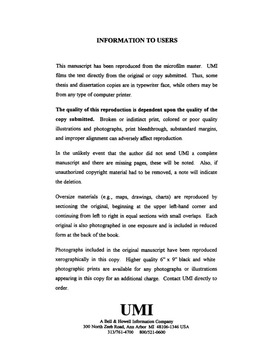| dc.contributor.advisor | Smagorinsky, Peter, | en_US |
| dc.contributor.author | Coppock, John William. | en_US |
| dc.date.accessioned | 2013-08-16T12:30:23Z | |
| dc.date.available | 2013-08-16T12:30:23Z | |
| dc.date.issued | 1999 | en_US |
| dc.identifier.uri | https://hdl.handle.net/11244/5742 | |
| dc.description.abstract | In phenomenology (Spiegelberg, 1984) if consciousness perceives value to sane approach in addressing problems (the phenomena arising through the participants, use of the heuristic coincide with participants' beliefs they perceive the problem better), then beneficial effect does exist in that manifestation. All known participants asserted the use of the heuristic, as realized in the context, coincided with improved effort and understandings of the problems. Considering each problem through the seven lenses effectively rendered problem better approached, and participants expressed a strong desire to work apart for as long as they liked initially in addressing problem and then to work with others, a move implying cooperative groups not be the first or only devices of problem solving invited by instruction. Participants also showed capacities to consider more aspects to problem than of a dominant intelligence, and participants found problem nay require more thought than textbooks may imply. | en_US |
| dc.description.abstract | This three-part phenomenological study begins in Gardner's (1983) theory of multiple intelligences but investigates its personal and social potentials to function heuristically and well in addressing the problem solving skills and schemata of secondary students (grades 8--12) or older persons. The study explicitly challenges Gardner's (1995) assertion that it is a waste of time to believe every problem can be approached effectively in at least seven different ways. Participants personally considered problems heuristically through the lenses of each of Gardner's (1983) seven intelligences with a metacognitive expectation that something would be of each venue in all problem. To test the general value of the method, the study contained a set of diverse problems (literary texts, music, paintings, and algebraic and social problem) and problem selected by participants themselves. The heuristic directions encouraged participants to mediate the problem in each of the seven venues. | en_US |
| dc.description.abstract | Although the study has findings probably seriously limited by its use of case data only from the researcher himself (Phase I) and ten somewhat diverse students (Phase II) and by their atypical educational setting in an adolescent drug treatment center, provision is in the study for a reader not of the setting to test the heuristic personally (Phase III). | en_US |
| dc.format.extent | 2 v. (xii, 804 leaves) : | en_US |
| dc.subject | Psychology, Cognitive. | en_US |
| dc.subject | Problem solving. | en_US |
| dc.subject | Multiple intelligences. | en_US |
| dc.subject | Cognitive styles. | en_US |
| dc.subject | Education, Curriculum and Instruction. | en_US |
| dc.title | Multiple intelligences. N characters in search for a solution: An approach for a personal and social heuristic. | en_US |
| dc.type | Thesis | en_US |
| dc.thesis.degree | Ph.D. | en_US |
| dc.thesis.degreeDiscipline | Department of Instructional Leadership and Academic Curriculum | en_US |
| dc.note | Source: Dissertation Abstracts International, Volume: 59-12, Section: A, page: 4348. | en_US |
| dc.note | Major Adviser: Peter Smagorinsky. | en_US |
| ou.identifier | (UMI)AAI9914395 | en_US |
| ou.group | Jeannine Rainbolt College of Education::Department of Instructional Leadership and Academic Curriculum | |
